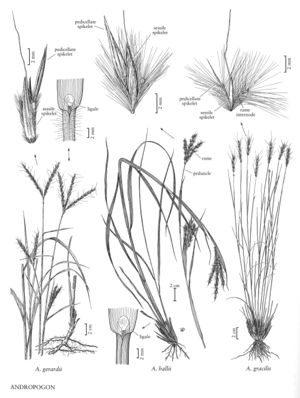Difference between revisions of "Andropogon hallii"
FNA>Volume Importer |
imported>Volume Importer |
||
| (8 intermediate revisions by 2 users not shown) | |||
| Line 7: | Line 7: | ||
|synonyms={{Treatment/ID/Synonym | |synonyms={{Treatment/ID/Synonym | ||
|name=Andropogon gerardii var. paucipilus | |name=Andropogon gerardii var. paucipilus | ||
| − | |authority= | + | |authority= |
| − | }}{{Treatment/ID/Synonym | + | |rank=variety |
| + | }} {{Treatment/ID/Synonym | ||
|name=Andropogon gerardii var. chrysocomus | |name=Andropogon gerardii var. chrysocomus | ||
| − | |authority= | + | |authority= |
| + | |rank=variety | ||
}} | }} | ||
|hierarchy=Poaceae;Poaceae subfam. Panicoideae;Poaceae tribe Andropogoneae;Andropogon;Andropogon sect. Andropogon;Andropogon hallii | |hierarchy=Poaceae;Poaceae subfam. Panicoideae;Poaceae tribe Andropogoneae;Andropogon;Andropogon sect. Andropogon;Andropogon hallii | ||
| Line 23: | Line 25: | ||
-->{{Treatment/Body | -->{{Treatment/Body | ||
|distribution=Colo.;N.Mex.;Tex.;Utah;Minn.;Kans.;N.Dak.;Nebr.;Okla.;S.Dak.;Mont.;Ill.;Ind.;Iowa;Ariz.;Wyo.;Man.;Sask. | |distribution=Colo.;N.Mex.;Tex.;Utah;Minn.;Kans.;N.Dak.;Nebr.;Okla.;S.Dak.;Mont.;Ill.;Ind.;Iowa;Ariz.;Wyo.;Man.;Sask. | ||
| − | |discussion=<p>Andropogon hallii grows on sandhills and in sandy soil. Its range extends through the central plains into northern Mexico. It is similar to A. gerardii, differing primarily in its rhizomatous habit, more densely pubescent rames and pedicels, and greater drought tolerance. Andropogon hallii and A. gerardii are sympatric in some locations. The two species can hybridize and are sometimes treated as conspecific subspecies.</p> | + | |discussion=<p><i>Andropogon hallii</i> grows on sandhills and in sandy soil. Its range extends through the central plains into northern Mexico. It is similar to <i>A. gerardii</i>, differing primarily in its rhizomatous habit, more densely pubescent rames and pedicels, and greater drought tolerance. <i>Andropogon hallii</i> and <i>A. gerardii</i> are sympatric in some locations. The two species can hybridize and are sometimes treated as conspecific subspecies.</p> |
|tables= | |tables= | ||
|references= | |references= | ||
| Line 32: | Line 34: | ||
-->{{#Taxon: | -->{{#Taxon: | ||
name=Andropogon hallii | name=Andropogon hallii | ||
| − | |||
|authority=Hack. | |authority=Hack. | ||
|rank=species | |rank=species | ||
| Line 39: | Line 40: | ||
|basionyms= | |basionyms= | ||
|family=Poaceae | |family=Poaceae | ||
| + | |illustrator=Linda A. Vorobik;Hana Pazdírková | ||
| + | |illustration copyright=Utah State University | ||
|distribution=Colo.;N.Mex.;Tex.;Utah;Minn.;Kans.;N.Dak.;Nebr.;Okla.;S.Dak.;Mont.;Ill.;Ind.;Iowa;Ariz.;Wyo.;Man.;Sask. | |distribution=Colo.;N.Mex.;Tex.;Utah;Minn.;Kans.;N.Dak.;Nebr.;Okla.;S.Dak.;Mont.;Ill.;Ind.;Iowa;Ariz.;Wyo.;Man.;Sask. | ||
|reference=None | |reference=None | ||
| Line 44: | Line 47: | ||
|publication year= | |publication year= | ||
|special status= | |special status= | ||
| − | |source xml=https:// | + | |source xml=https://bitbucket.org/aafc-mbb/fna-data-curation/src/200273ad09963decb8fc72550212de541d86569d/coarse_grained_fna_xml/V25/V25_1574.xml |
|subfamily=Poaceae subfam. Panicoideae | |subfamily=Poaceae subfam. Panicoideae | ||
|tribe=Poaceae tribe Andropogoneae | |tribe=Poaceae tribe Andropogoneae | ||
Latest revision as of 17:57, 11 May 2021
Plants strongly rhizomatous, rhizome internodes often longer than 2 cm. Culms (40)60-150(200) cm, strongly glaucous. Ligules (0.9)2.5-4.5 mm, ciliate; blades 3-40(51) cm long, (1.5)2-10 mm wide, often pilose, at least near the collar. Inflorescence units usually only terminal; peduncles with 2-7 rames; rames 4-7(9) cm, exserted at maturity; internodes usually densely pubescent, hairs 3.7-6.6 mm, often strongly yellowish. Sessile spikelets (5)6.5-12 mm; lower glumes often ciliate; awns absent or to 11 mm; anthers 3, (2.3)4-6 mm. Pedicellate spikelets 3.5-12 mm, usually well-developed and staminate. 2n = 60 (usually), 70, 100.
Distribution
Colo., N.Mex., Tex., Utah, Minn., Kans., N.Dak., Nebr., Okla., S.Dak., Mont., Ill., Ind., Iowa, Ariz., Wyo., Man., Sask.
Discussion
Andropogon hallii grows on sandhills and in sandy soil. Its range extends through the central plains into northern Mexico. It is similar to A. gerardii, differing primarily in its rhizomatous habit, more densely pubescent rames and pedicels, and greater drought tolerance. Andropogon hallii and A. gerardii are sympatric in some locations. The two species can hybridize and are sometimes treated as conspecific subspecies.
Selected References
None.
